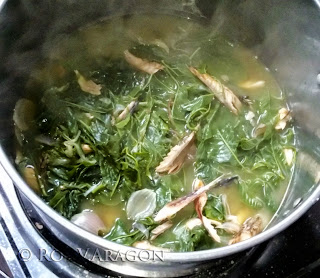Well, yeas, of course, the leaves of the alukon (allaeanthus glaber), also alokon, bungon, baeg, himbabao, is also edible, and is a great leafy green for an Ilokano dinengdeng. It's not just the flowers, you see.
Here's one tasty dinengdeng using alukon leaves only, made more delicious and flavorful with smoked fish (tinapa):
Cooking this Ilokano dish is simple. Just boil bugguong first, with some onion slices and then put in the washed leaves and the flaked tinapa into the boiling broth:
Simmer for a few minutes....
And it's done:
Serve the dinengdeng immediately while hot and steaming, the smoky aroma is so overwhelming it makes you salivate:
Here. it's perfect for your steamed rice, old or newly cooked. The broth is so tasty, perfect for a hearty labay:
Here's one tasty dinengdeng using alukon leaves only, made more delicious and flavorful with smoked fish (tinapa):
Cooking this Ilokano dish is simple. Just boil bugguong first, with some onion slices and then put in the washed leaves and the flaked tinapa into the boiling broth:
Simmer for a few minutes....
And it's done:
Serve the dinengdeng immediately while hot and steaming, the smoky aroma is so overwhelming it makes you salivate:
Here. it's perfect for your steamed rice, old or newly cooked. The broth is so tasty, perfect for a hearty labay:



















